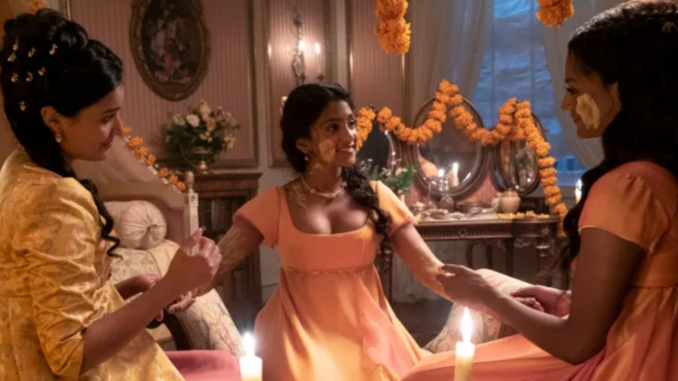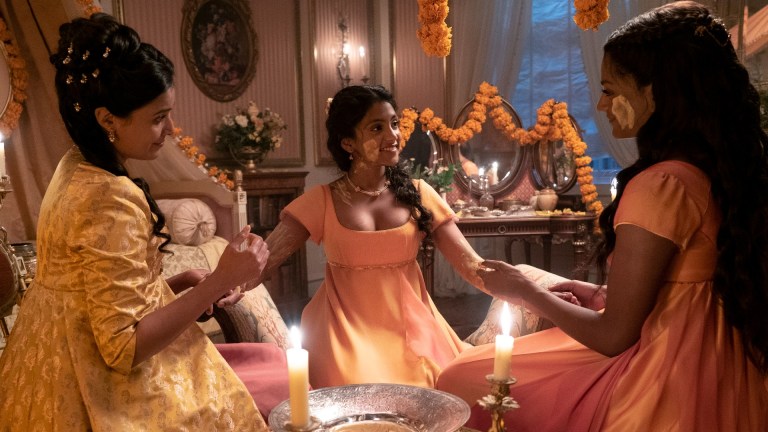
Bridgerton Season 2 Plots a New Path for South Asian Representation in Period Dramas
The decision to cast Kate, Edwina, and Lady Mary from the series in season 2 of Bridgerton as South Asian women is a rare one for Regency-era productions. But, just as Bridgerton season 1 paved the way for more black representation in British period dramas, the show’s second season could have done the same for four South Asians.
While the show’s portrayal of the Sharma family has been received differently by some South Asian viewers (more on that later), it’s actually a welcome development for this type of storytelling. Bridgerton is making an argument for future period dramas to continue to move away from glorifying British imperialism and create more opportunities for South Asian actors.
It’s important to note that Bridgerton was never intended to be a perfect recreation of history, but the show did seek advice from South Asian experts on characterisation and historical context. Dr Priya Atwal, who wrote a book on the Sikh Empire in the late 18th century, advised the cast on the historical background of the Sharma family. Dr Hannah Greig also advised on Regency-era British etiquette and life in The Ton. All of this consulting work had to balance the show’s main task of adapting Julia Quinn’s The Viscount Who Loved Me for the screen.

Simone Ashley and Charithra Chandran’s casting as Kate and Edwina could be seen as a response to critics of season 1 who accused the show of being colourist and focusing on highlighting only one type of racial/ethnic diversity. In press notes provided by Netflix to critics, creator Shonda Rimes said, “Finding some darker-skinned South Asian women and making sure that they were represented authentically and honestly on screen felt like something that we hadn’t seen enough of…. And the idea that they come from a different culture, we weaved that into the story in a wonderful way to enhance the idea that our characters’ British values aren’t necessarily the only values worth having. That’s reflected in Kate’s reaction to the British tea—but really, it’s a very important way to make sure that we’re bringing the world into this.”
Bridgerton season 2 combines representations of several regions and cultures of India. Edwina says in episode 1 that she can speak Marathi and Hindustani. Kate, whose full name is Kathani, affectionately calls Edwina “bon,” which Chandran said in an interview could be Bengali for “little sister” or similar to the French word for sweet. If you listen closely, the sisters often change their accents at home compared to when talking to other members of the Ton. The season also normalizes traditions like Edwina bathing in haldi (turmeric) as part of her wedding preparations. A cover of “Kabhi Khushi Kabhie Gham” is played alongside the usual pop covers. All of these elements add up to show that Kate and Edwina will have a different perspective on what they want in life than the Bridgerton and Featherington siblings.
For those If anyone doubts the authenticity of Kate or Edwina marrying an English suitor, there are real-life examples of interracial marriages from this era. Historian Dr. Durba Ghosh, a professor at Cornell University, wrote a paper earlier this year about the real-life figures Elizabeth Ducarel, Kitty Kirkpatrick, and Helene Bennett, elite South Asian women who lived in Regency England and married white men. While it’s possible these women experienced varying degrees of racism, the Sharmas’ negative experiences during this social season are entirely blamed on Lady Mary’s parents, who have been feuding for 30 years. Kate repeatedly mentions returning to India in early episodes because she doesn’t want to get married.
Like the previous season, Bridgerton season 2 relies heavily on costume details to convey culture. Kate and Edwina’s outfits deliberately incorporate pashmina shawls, beaded jewelry, and other Indian-inspired details. Historical costume enthusiasts have found dresses in museums that are similar in style to Kate and Edwina’s. Madame Delacroix and rival couturiers stocked their stores with a wide variety of silks, cottons, and linens. Textile history shows that India was the main source of silks and muslin (fine cotton from Bangladesh). Both seasons feature scenes of tea drinking, also an Indian product. All of these products came to England via the British East India Company.
